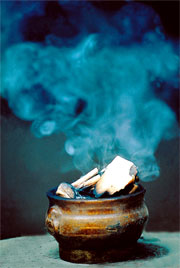
Dongguan is located in the east of Guangzhou, and became well known for producing Juncellus serotinus (Dongguan grass), a type of salt water plant which grows near the sea or near areas with salt water. In ancient times, Dongguan Grass was mainly used to weave grass mats. This technique is more than 2,000 years old. Similar artifacts were found in the Han Dynasty Tombs in Changsha, Hunan. Ancient Dongguan weaving was mostly carried out in 5 towns of Dongguan, including Houjie, Daojiao, Humen, Guancheng and Wangniudun. These areas had high quality Dongguan grass thus producing large amount of grass-woven products. Before the 1980s, export of grass mats and grass-woven products were as popular as silk exports, playing an important role in developing the local economy.
Aquilaria Sinensis (also named Guan Xiang) started to be cultivated as a type of herb during the Tang Dynasty, later becoming famous nationwide during in the Ming and Qing Dynasties. At that time, it was also a common tribute to the Emperor. Today, records of Guan Xiang can still be found in the Forbidden City. The Guan Xiang Tree is the only tree named after Dongguan, where it has a long history. Records state that the tree was first introduced during the Tang Dynasty. By the Song Dynasty, it was widely planted in Guangdong, especially in Dongguan. The “Dongguan County Annals” written in the late Qing Dynasty stated, Guan Xiang became famous again in the Ming Dynasty. Recently, a novel “Century of Guan Xiang” tells the story of Guan Xiang for the first time through literature.
The “New History of Guangdong” also tells the story of Guan Xiang being sold to the North where it is written, “While passing by the mountains on the way to the North, Guan Xiang continues smelling sweet even in the harshest conditions. In its most popular era, the revenue from selling Guan Xiang was more than 10,000 ounces of gold each year. During the mid-autumn festival, Guan Xiang will be burnt throughout the night in a ceremony known as ‘smoking the moon’. The story also talks about the character of Guan Xiang in its natural environment, representing the spirit of perseverance and determination, honesty and courage of the Dongguan people.
